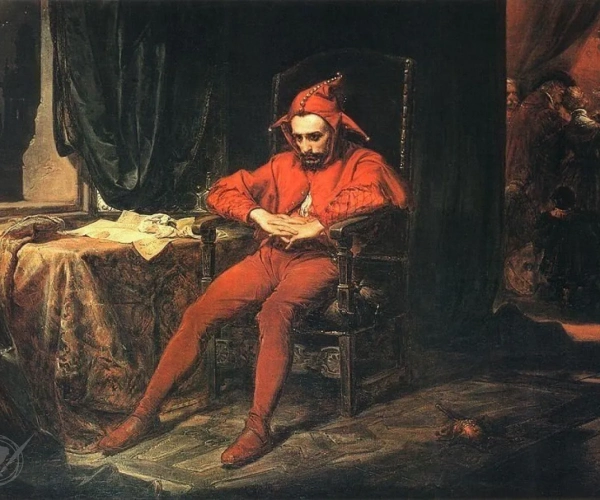Stanczyk during a Ball at the Court of Queen Bona after the Loss of Smolensk
Jan Matejko's "Sta?czyk during a Ball at the Court of Queen Bona after the Loss of Smolensk" is a masterful depiction of a historical event with a touch of satire and deep emotional resonance. Matejko, known for his accurate portrayal of historical scenes, captures a moment of contemplation and sorrow in the character of Sta?czyk, the court jester. The painting is set against the backdrop of the Polish-Lithuanian Commonwealth in the 16th century, during the reign of Queen Bona Sforza, and it reflects the national tragedy of the loss of the city of Smolensk to the Russians in 1514.
The painting's composition is striking, as Sta?czyk stands out amidst the opulence and revelry of the court. His facial expression, a mix of sadness and introspection, contrasts sharply with the merriment around him. This creates a poignant juxtaposition, drawing attention to the gravity of the political situation and the burden carried by the protagonist. The use of light and shadow accentuates Sta?czyk's features, emphasizing the depth of his emotions and inner turmoil.
Matejko's meticulous attention to detail is evident in the rich, ornate costumes and intricate architectural elements, which help to situate the viewer in the historical context. The artist's choice of color palette, dominated by deep, rich tones, adds to the solemn atmosphere of the painting, reinforcing the emotional weight of the subject matter. The overall composition exudes a sense of melancholy and contemplation, inviting the viewer to empathize with Sta?czyk's plight and reflect on the broader themes of loss, patriotism, and resilience.
Furthermore, the inclusion of subtle symbolic elements, such as the discarded goblet and the jester's staff, adds layers of meaning to the artwork, inviting interpretation and contemplation. Through these details, Matejko invites viewers to contemplate the complexities of power, loyalty, and the human experience in the face of adversity.
In conclusion, "Sta?czyk during a Ball at the Court of Queen Bona after the Loss of Smolensk" stands as a powerful testament to Jan Matejko's prowess as a historical painter. Through his masterful composition, meticulous attention to detail, and profound emotional resonance, Matejko breathes life into a pivotal moment in Polish history, inviting viewers to engage with the universal themes of loss, patriotism, and the enduring human spirit.







No Comments Yet...